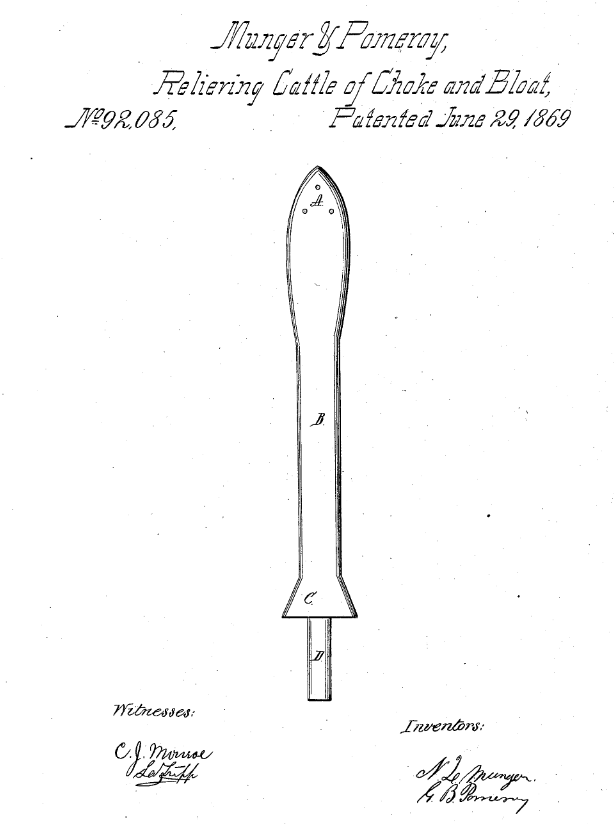N.Q. MUNGER, OF CASCO, AND G.B. POMEROY, OF SOUTH HAVEN, MICHIGAN.
Letters Patent No. 82,085, dated June 29, 1869.
IMPROVEMENT IN INSTRUMENTS FOR RELIEVING CHOAK AND BLOAT IN CATTLE.
The Schedule referred to in these Letters Patent and
making part of the same.
To all whom it may concern:
Be it known that we, N.Q. MUNGER of Casco, Allegan County, Michigan, and
G.B. POMEROY, of South Haven, Van Buren couty, Michigan, have invented an Improvement upon "Esophagus-Tubes," for which Letters Patent
were granted to said N.Q. MUNGER, July 10, 1860; and we do hereby declare that the following is a full and exact description thereof,
reference being had to the accompanying drawing, and to the letters of reference marked thereon, which drawing is a plan view of said
invention.
The nature of our invention may be better understood from a brief description of the former invention, upon
which this is an improvement, followed by a statement of the character of the improvement, and the purposes for which it is intended.
The original invention of Mr. MUNGER, was an instrument intended for the speedy and effective relief of cattle suffering
from choke or bloat, and consisted of a tube, the middle portion being made of a closely-wound coil of wire, and covered with leather,
or other suitable material.
One end of said tube is open, with a flaring mouth-piece, and the other end closed, and expanded
in the form of an egg, and perforated with a number of holes.
To relieve cattle from choke, the open end was passed down the
throat of the beast until it touched the obstacles, and pushed them down; the flaring shape of the end, and the flexibility of the tube,
making it effective instantly; without injury to the animal.
In case of bloat, the closed end of the tube was passed into
the anus, and when it reached the part affected, the egg-shaped form of said end enlarged the passage, and allowed the gas to escape
through the perforations into the tube, and so out of the tube.
It was found in use, that the instrument was quite expensive
in its first cost, mainly from the employment of the coiled wire; that for the same reason it was difficult to clean; and the wire easily
rusting, it was liable to get out of repair in a short time, and was not easily repaired, because, to make such repair, it was necessary
to remove the leather covering.
In addition to this, it could not be used for purposes of injection, which is often essential
in the treatment of diseases of cattle.
Our improvement, therefore, is the employment of a tube, of the general form of that
in the original invention, made of leather, gutta-percha, or India rubber, and about four feet long.
In combination with
this tube, for injection-purposes, we use a flexible piston, of proper length, made of leather, gutta-percha, or India rubber.
A more particular description is as follows:
B is a cylindrical tube, made of leather, gutta-percha, or India rubber, having
an open end, C, with a flaring mouth, and a closed end, A, egg-shaped, and larger than the middle of the tube, with several performations
near its point.
The inner diameter of this tube is the same throughout its entire length.
A piston, D, of
similar material as the tube, and somewhat longer that it, has its front end packed so as to fit tightly to the inside.
To relieve cattle from choke, remove the piston D, and introduce the end, C, of the tube into the mouth of the animal, and pass it down
the throat, pushing with it all obstructions into the stomach.
To relieve from bloat, remove the piston D, and introduce the
end A, of the tube B, into the anus of the animal, and push it along until it reaches the part affected, when the gases will escape through
the perforations into the tube, and through the tube into the air.
In case of bloody murrain, or in any disease where an
injection is desirable, pass the end A, of the tube B, without the piston, into the anus of the animal until it reaches the part to be
relieved, then pour into it theliquor to be injected, and then, placing the piston D into the tube, use it as a syringe.
This instrument is an improvement upon the former invention, in flexibility, in cheapness, in durability, in cleanliness, in greater ease
of repair, and in its combination wiht a piston; can be used in a larger class of diseases, and in that respect is more effective.
What we claim as our invention, and desire to secure by Letters Pattent, is--
The piston D, in combination
with an instrument for the relief of choke and bloat, it consisting of a tube, B, with flaring open end C, and perforated egg-shaped
end A. constructed and operating as above described.N.Q. MUNGER. [L.S.]
G.B. POMEROY. [L.S.]
Witnesses:
THOS. HEWSON,
S.A. SIMMONS.
|
 Click to enlarge
Click to enlarge
image from patent
application |




 Return
To Home Page
Return
To Home Page
